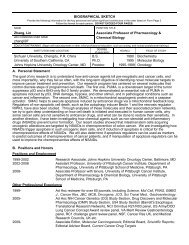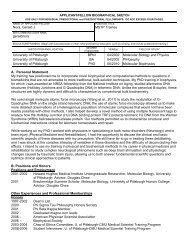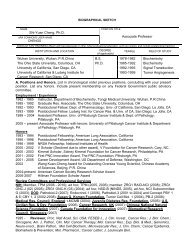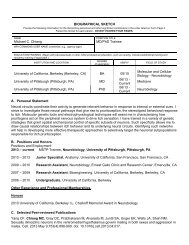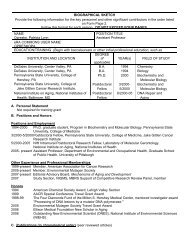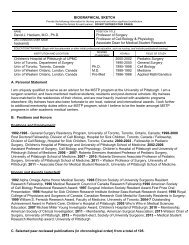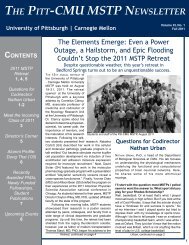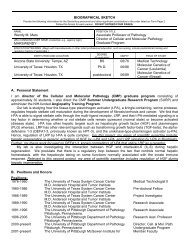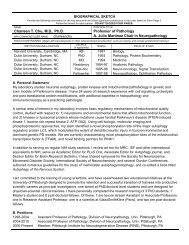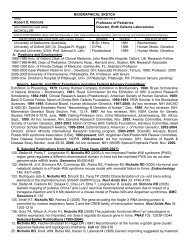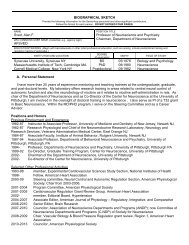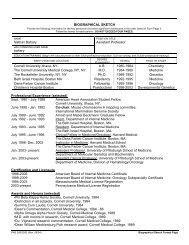BIOGRAPHICAL SKETCH Joseph M. Ahearn Associate Professor of ...
BIOGRAPHICAL SKETCH Joseph M. Ahearn Associate Professor of ...
BIOGRAPHICAL SKETCH Joseph M. Ahearn Associate Professor of ...
Create successful ePaper yourself
Turn your PDF publications into a flip-book with our unique Google optimized e-Paper software.
NAME<br />
<strong>Joseph</strong> M. <strong>Ahearn</strong><br />
eRA COMMONS USER NAME<br />
jahearn<br />
<strong>BIOGRAPHICAL</strong> <strong>SKETCH</strong><br />
POSITION TITLE<br />
<strong>Associate</strong> <strong>Pr<strong>of</strong>essor</strong> <strong>of</strong> Medicine, with Tenure<br />
EDUCATION/TRAINING (Begin with baccalaureate or other initial pr<strong>of</strong>essional education, such as nursing, and include postdoctoral<br />
t i i )<br />
INSTITUTION AND LOCATION<br />
DEGREE<br />
(if applicable)<br />
YEAR(s) FIELD OF STUDY<br />
Cornell University, Ithaca, NY BS 1977 Anatomy & Physiology<br />
Johns Hopkins School <strong>of</strong> Medicine, Baltimore, MD 1981 Medicine<br />
Johns Hopkins Hospital, Baltimore, MD Intern 1982 Medicine<br />
Johns Hopkins Hospital, Baltimore, MD Resident 1984 Medicine<br />
A. Positions and Honors<br />
Positions<br />
1984-86 Fellowship Rheumatology, The Johns Hopkins Hospital<br />
1984-87 Fellowship Department <strong>of</strong> Molecular Biology & Genetics<br />
1986-87 Instructor Department <strong>of</strong> Medicine; The Johns Hopkins University School <strong>of</strong> Medicine<br />
1987-92 Assistant <strong>Pr<strong>of</strong>essor</strong> Department <strong>of</strong> Medicine; The Johns Hopkins University School <strong>of</strong> Medicine<br />
1992-96 <strong>Associate</strong> <strong>Pr<strong>of</strong>essor</strong> Department <strong>of</strong> Medicine; The Johns Hopkins University School <strong>of</strong> Medicine<br />
1993-96 Joint Appointment Department <strong>of</strong> Molecular Biology & Genetics;<br />
The Johns Hopkins University School <strong>of</strong> Medicine<br />
1993-96 Member The Graduate Immunology Training Program;<br />
The Johns Hopkins University School <strong>of</strong> Medicine<br />
1993-96 Co-director Rheumatology Fellowship Training Program;<br />
The Johns Hopkins University School <strong>of</strong> Medicine<br />
1996- <strong>Associate</strong> <strong>Pr<strong>of</strong>essor</strong> Division <strong>of</strong> Rheumatology & Clinical Immunology; Department <strong>of</strong> Medicine<br />
University <strong>of</strong> Pittsburgh School <strong>of</strong> Medicine<br />
1996- Director <strong>of</strong> Research University <strong>of</strong> Pittsburgh Arthritis Institute<br />
2000- Member Cardiovascular Institute <strong>of</strong> the UPMC Health System<br />
2001- Co-Director Lupus Center <strong>of</strong> Excellence, University <strong>of</strong> Pittsburgh Medical Center<br />
2000-2004 Member NIH Study Section – Allergy and Immunology<br />
2003- Member NIH NIAMS Council AMS 1<br />
2004- Chair NIH Special Emphasis Panel: Elements <strong>of</strong> Innate Immunity<br />
2006 Chair NIAMS Special Emphasis Panel: K awards<br />
2004- Member NIH SBIR/STTR Special Emphasis Panel; NIH National Center for<br />
Research Resources (NCRR) Special Emphasis Panel; NIH GCRC Special Emphasis Panel;<br />
NIH Special; Emphasis Panel:Topics in Gut and Brain Innate Immunity; NIH Special Emphasis<br />
Panel: Innate Immunity; NIH Study Section: Innate Immunity and Inflammation; NIH Special<br />
Emphasis Panel: SLE; NIH Special Emphasis Panel: SLE; Lupus Panel; Department <strong>of</strong><br />
Defense; Scientific Peer Advisory and Review; NIH Special Emphasis: Immunology IRG Special<br />
Study Section; NIH NIAMS Special Emphasis Panel: Centers for Research Translation; NIH<br />
NIAMS Special Emphasis Panel: R03; NIH Special Emphasis Panel: CNS Injury; NIH Special<br />
Emphasis Panel: NIAID; NIH Special Emphasis Panel: Kidney Monitoring and Therapeutics;<br />
Wellcome Trust Clinical Infrastructure Research Grants, Clinical and Translational Science<br />
Study Section; Executive Editor Clinical and Translational Science<br />
2005 Co-Founder Stagemark, Inc. (became Cellatope in 2007)<br />
Honors<br />
1977 Phi Beta Kappa; Phi Kappa Phi<br />
1981 The Johns Hopkins Medical Student Research Award<br />
1983 Alpha Omega Alpha<br />
1984 W. Barry Wood Scholarship; NIH Physician Scientist Training Award<br />
1990 Hilda Irene Duggan Arthritis Investigator * Given annually to the highest ranked Arthritis Investigator grant proposals<br />
1994-2000 <strong>Associate</strong> Editor, Journal <strong>of</strong> Immunology<br />
2005 Pitt Innovator Award
2006 Pitt Innovator Award<br />
B. Selected Publications<br />
1. Lowell CA, Klickstein LB, Carter RH, Mitchell JA, Fearon DT, <strong>Ahearn</strong> JM. Mapping <strong>of</strong> the Epstein<br />
Barr virus and C3dg binding sites to a common domain on complement receptor type 2. J Exp Med.<br />
1989;170:1931-1946.<br />
2. Tuveson DA, <strong>Ahearn</strong> JM, Matsumoto AK, Fearon DT. Molecular interactions <strong>of</strong> complement receptor<br />
on B lymphocytes: A CR1/CR2 complex distinct from the CR2/CD19 complex. J Exp Med. 1991;173:1083-<br />
1089.<br />
3. Kalli KR, <strong>Ahearn</strong> JM, Fearon DT. Interaction <strong>of</strong> iC3b with recombinant isotypic and chimeric forms <strong>of</strong><br />
CR2. J Immunol. 1991;147:590-594.<br />
4. Hebell T, <strong>Ahearn</strong> JM, Fearon DT. Suppression <strong>of</strong> the immune response by a soluble complement<br />
receptor <strong>of</strong> B lymphocytes. Science. 1991;254:102-105.<br />
5. Martin DR, Kalli KR, Yuryev A, Fearon DT, <strong>Ahearn</strong> JM. Determination <strong>of</strong> the structural basis for selective<br />
binding <strong>of</strong> Epstein-Barr virus to human complement receptor type 2. J Exp Med. 1991;174:1299-1311.<br />
6. Kalli KR, Hsu P, Bartow TJ, <strong>Ahearn</strong> JM, Matsumoto AK, Klickstein LB, Fearon DT. Mapping <strong>of</strong> the<br />
C3b-binding site <strong>of</strong> CR1 and construction <strong>of</strong> a (CR1)2-F(ab)2 chimeric complement inhibitor. J Exp Med.<br />
1991;174:1451-1460.<br />
7. Montefiore DC, Stewart K, <strong>Ahearn</strong> JM, Zhou J, Zhou J. Complement-mediated binding <strong>of</strong> naturally<br />
glycosylated and glycosylation-modified HIV-1 to human CR2 (CD21). J Virol. 1992;67:2699-2706.<br />
8. Matsumoto AK, Martin DR, Carter RH, Klickstein LB, <strong>Ahearn</strong> JM, Fearon DT. Functional dissection <strong>of</strong><br />
the CD21/CD19/TAPA-1/Leu-13 complex <strong>of</strong> B lymphocytes. J Exp Med. 1993;178:1407-1417.<br />
9. Martin DR, Marlow RL, <strong>Ahearn</strong> JM. Determination <strong>of</strong> the role for CD21 during Epstein-Barr virus<br />
infection <strong>of</strong> B lymphoblastoid cells. J Virol. 1994;68:4716-4726.<br />
10. Montefiore DC, Graham BS, Zhou JY, Zhou JT, <strong>Ahearn</strong> JM. Binding <strong>of</strong> human immunodeficiency virus<br />
type 1 to the C3b/C4b receptor CR1 (CD35) and red blood cells in the presence <strong>of</strong> envelope-specific<br />
antibodies and complement. J Infect Dis. 1994;170:429-432.<br />
11. Rosen A, Casciola-Rosen L, <strong>Ahearn</strong> JM. Novel packages <strong>of</strong> viral and self antigens are generated<br />
during apoptosis. J Exp Med. 1995;181:1557-1561.<br />
12. Croix DA, <strong>Ahearn</strong> JM, Rosengard AM, Han S, Kelsoe G, Ma M, Carroll MC. Antibody response to a Tdependent<br />
antigen requires B cell expression <strong>of</strong> complement receptors. J Exp Med. 1996;183:1857-1864.<br />
13. <strong>Ahearn</strong> JM, Fischer MB, Croix DA, Goerg S, Ma M, Xia J, Zhou X, Rothstein T, Carroll MC. Disruption <strong>of</strong><br />
the Cr2 locus results in a reduction in B-1a cells and in an impaired B cell response to T-dependent<br />
antigen. Immunity. 1996;4:251-262.<br />
14. Karp CL, Wysocka M, Wahl LM, <strong>Ahearn</strong> JM, Cuomo PJ, Sherry B, Trinchieri G, Griffin DE. Inhibition<br />
<strong>of</strong> interleukin-12 production by viral and complement ligands for CD46. Science. 1996;273:228-231.<br />
15. Korb LC, <strong>Ahearn</strong> JM. C1q binds directly and specifically to surface blebs <strong>of</strong> apoptotic human<br />
keratinocytes: Complement deficiency and systemic lupus erythematosus revisited. J Immunol (Cutting<br />
Edge). 1997;158:4525-4528.<br />
16. Navratil JS, Korb LC, <strong>Ahearn</strong> JM. Systemic lupus erythematosus and complement deficiency: Clues<br />
to a novel role for the classical complement pathway in the maintenance <strong>of</strong> immune tolerance.<br />
Immunopharm. 1999;42:47-52.<br />
17. Rosengard AM, <strong>Ahearn</strong> JM. Viral complement regulatory proteins. Immunopharm. 1999;42:99-106.<br />
18. Rosengard AM, Alonso LC, Korb LC, Baldwin MW III, Sanfilippo F, Turka LA, <strong>Ahearn</strong> JM. Functional<br />
characterization <strong>of</strong> soluble and membrane-bound forms <strong>of</strong> vaccinia virus complement control protein<br />
(VCP). Mol Immunol. 1999;36:684-697.<br />
19. Johnson AA, Rosengard AM, Skjodt K, <strong>Ahearn</strong> JM, Leslie GQ. The structural basis for complement<br />
receptor type 2 (CR2, CD21)-mediated alternative pathway activation <strong>of</strong> complement: Studies with CR2<br />
deletion mutants and vaccinia virus complement-control protein-CR2 chimeras. Eur J Immunol.<br />
1999;29:3837-3844.<br />
20. Navratil JS, <strong>Ahearn</strong> JM. Apoptosis and autoimmunity: Complement deficiency and systemic lupus<br />
erythematosus revisited. Curr Rheum Reports. 2000;2:32-38.<br />
21. Navratil JS, Watkins SC, Wisnieski JJ, <strong>Ahearn</strong> JM. The globular heads <strong>of</strong> C1q specifically recognize<br />
surface blebs <strong>of</strong> apoptotic vascular endothelial cells. J Immunol. 2001;166:3231-3239.<br />
22. Navratil JS, <strong>Ahearn</strong> JM. Apoptosis, clearance mechanisms, and the development <strong>of</strong> SLE. Curr
Rheum Reports. 2001;3(3):191-198.<br />
23. Liu C-C, <strong>Ahearn</strong> JM. Apoptosis <strong>of</strong> skeletal muscle cells and the pathogenesis <strong>of</strong> myositis: A<br />
perspective. Curr Rheum Reports 2001;3:325-333.<br />
24. Manzi S, <strong>Ahearn</strong> JM, Salmon J. New insights into complement: A mediator <strong>of</strong> injury and marker <strong>of</strong><br />
disease activity in SLE. Lupus. 2004;13:298-303.<br />
25. Liu CC, Manzi S, Danchenko N, <strong>Ahearn</strong> JM. New advances in measurement <strong>of</strong> complement activation:<br />
Lessons <strong>of</strong> systemic lupus erythematosus. Curr Rheumatol Rep 2004;6:375-381.<br />
26. Liu CC, <strong>Ahearn</strong> JM, Manzi S. Complement as a source <strong>of</strong> biomarkers for SLE: Past, present and future.<br />
Curr Rheumatol Rep. 2004;6:85-88.<br />
27. Manzi S, Navratil JS, Ruffing MJ, Liu CC, Danchenko N, Nilson S, Krishnaswami S, King DE, Kao AH,<br />
<strong>Ahearn</strong> JM. Measurement <strong>of</strong> erythrocyte C4d and complement receptor 1 in systemic lupus<br />
erythematosus. Arthritis Rheum. 2004;50:3596-3604.<br />
28. Liu CC, Navratil JS, Sabatine JM, <strong>Ahearn</strong> JM. Apoptosis, complement and systemic lupus<br />
erythematosus: A mechanistic view. Curr Directions in Autoimmunity. 2004;7:49-86.<br />
29. Liu CC, <strong>Ahearn</strong> JM. Acute-phase proteins and inflammation: immunological and clinical implications. In:<br />
Lotze, MT, Thomson AW, editors. Measuring Immunity: Basic Biology and Clinical Assessment. London:<br />
Elsevier Academic Press;2005. p.131-134.<br />
30. Liu CC, <strong>Ahearn</strong> JM. Complement in Health and Disease. In: Lotze MT, Thomson AW, editors. Measuring<br />
Immunity: Basic Biology and Clinical Assessment. London: Elsevier Academic Press;2005. p.144-147.<br />
31. Liu CC, Manzi S, Kao AH, Ruffing MJ, <strong>Ahearn</strong> JM. Reticulocytes bearing C4d as biomarkers <strong>of</strong> disease<br />
activity for systemic lupus erythematosus.Arthritis Rheum. 2005;52:3087-3099.<br />
32. Liu CC, Manzi S, <strong>Ahearn</strong> JM. Biomarkers for systemic lupus erythematosus: a review and prospective.<br />
Curr Opinion Rheumatol. 2005;17:543-549.<br />
33. Liu C-C, Danchenko N, Navratil JS, Nilson SE, Manzi S, <strong>Ahearn</strong> JM. Mining the complement system<br />
for lupus biomarkers. Clinic Appl Immunol Rev. 2005;5:185-106.<br />
34. Navratil JS, Manzi S, Kao AH, Krishnaswami S, Liu CC, Ruffing MJ, Shaw PS, Nilson AC, Dryden ER,<br />
Johnson JJ, <strong>Ahearn</strong> JM. Platelet C4d is highly specific for systemic lupus erythematosus. Arthritis<br />
Rheum. 2006;54:670-674.<br />
35. Calano, S, Shih Pei-an B, Liu, CC, Kao AH, Navratil JS, Manzi, S, <strong>Ahearn</strong> JM. Cell-bound complement<br />
activation products (CB-CAPs) as a source <strong>of</strong> lupus biomarkers. Adv Exp Med Biol. 2006;586:381-90.<br />
36. Liu CC, <strong>Ahearn</strong> JM. Complement and Systemic lupus erythematosus. In: Wallace DJ, Hahn BH, editors.<br />
Dubois’ Lupus Erythematosus. Philadelphia: Lippincott Williams & Wilkins; 2006.<br />
37. Piao W, Liu CC, Kao A, Manzi S, Vogt M, Ruffing M, <strong>Ahearn</strong> JM. Mannose-Binding Lectin is a<br />
Disease-Modifying Factor in North American Patients with Systemic Lupus Erythematosus. J. Rheum.<br />
2007; 34(7):1506-1513.<br />
38. Santelices LC, Calano SJ, Erhart JC, Prantil RL, Haney JL, Vorp DA, <strong>Ahearn</strong> JM. Experimental system<br />
for ex vivo measurement <strong>of</strong> murine aortic stiffness. Physiol Meas. 2007. 28: N39-N49.<br />
39. Santelices LC, Calano SJ, Prantil RL, Vorp DA, <strong>Ahearn</strong> JM. Relative Contributions <strong>of</strong> Age and<br />
Atherosclerosis to Vascular Stiffness. Clinical and Translational Science. 2008; 1(1): 62-66.<br />
40. Mehta N, Uchino K, Fakhran S, Sattar A, Branstetter BF, Au K, Navratil JS, Paul B, Lee M, Gallagher K,<br />
Manzi S, <strong>Ahearn</strong> JM, Kao AH. Platelet C4d is <strong>Associate</strong>d with Severity <strong>of</strong> Acute Ischemic Stroke. Stroke.<br />
2008;39: 3236-3241.<br />
41. Manzi S and <strong>Ahearn</strong> J. The Lupus Center <strong>of</strong> Excellence: A Model for Integrated Patient Care and Clinical-<br />
Translational Research. Clinical and Translational Science. 2008; 1(2): 96-98.<br />
C. Research Support<br />
Ongoing Research Support<br />
5 R01 HL074335-05 (<strong>Ahearn</strong>) 07/01/03 – 06/30/09<br />
NIH/NHLBI<br />
Erythrocytes as Time Capsules <strong>of</strong> Disease Activity in SLE<br />
The long-term goals <strong>of</strong> this proposal are to verify the hypothesis that erythrocyte-bound complement may serve<br />
as a novel biomarker <strong>of</strong> SLE disease activity, and to investigate human C4 polymorphism and SLE.<br />
Role: PI<br />
Department <strong>of</strong> Defense (Tsokos) 05/31/07 - 04/30/10<br />
W81XWH-06-2-0038
T Cell Lipid Rafts and Complement Ligands for Diagnosis and Monitoring <strong>of</strong> SLE<br />
The major goals <strong>of</strong> this study are to: 1) characterize the phenotype and function <strong>of</strong> T cells in SLE patients<br />
with respect to deposition <strong>of</strong> complement activation products, 2) investigate the functional consequence <strong>of</strong><br />
complement deposition on T cells, and 3) correlate complement deposition on T cells with SLE disease<br />
activity.<br />
Role: Co-Investigator<br />
5R01 AR046588-07 (Manzi) 07/01/01 – 08/30/11<br />
NIH/NIAMS<br />
Progression <strong>of</strong> Cardiovascular Disease in Lupus<br />
A longitudinal study to determine the risk factors <strong>of</strong> CVD in SLE and the role <strong>of</strong> active inflammation.<br />
Role: Co-Investigator<br />
U01 A1077867 (Weber) 03/01/08 – 02/28/13<br />
NIH/NIAID/NHLBI<br />
Alloantibodies in Cardiac Transplantation – Intervention, Outcomes, and Mechanisms<br />
This application brings together a group <strong>of</strong> six leading heart transplant centers, and leading transplantation<br />
scientists, to study the impact <strong>of</strong> preformed and de novo alloantibodies on pediatric heart transplant outcomes.<br />
We will investigate the development <strong>of</strong> a non-invasive marker <strong>of</strong> humoral rejection and complement activation:<br />
quantitative measurement <strong>of</strong> cell bound complement activation products (CB-CAP’s).<br />
Role: Co-Investigator<br />
1 R01 AI077591-01 (Liu)<br />
NIH/NIAID 09/25/08 – 08/31/12<br />
Lymphocyte-Bound Complement Activation Products: Clues to SLE Pathogenesis<br />
The specific aims <strong>of</strong> the proposal are: 1) to characterize the CAP-bearing phenotype <strong>of</strong> T cells in SLE patients<br />
and elucidate the mechanism(s) causing this phenotype, focusing particularly on the ALA-dependent<br />
mechanism, 2) to characterize ALAs and identify their candidate antigen targets, 3) to investigate the impact <strong>of</strong><br />
ALA and T cell-bound CAPs (T-CAP) on T cell function in SLE and 4) to determine the correlation between<br />
ALA/T-CAP levels, T cell dysfunction, and SLE disease activity.<br />
Role: Co-Investigator<br />
Lupus Foundation <strong>of</strong> America (<strong>Ahearn</strong>) 10/01/08 – 09/30/09<br />
Biomarkers for Diagnosis, Monitoring and Prognosis in Pediatric SLE<br />
In this collaborative multi-center study, we propose to conduct a longitudinal investigation <strong>of</strong><br />
CB-CAPs as potential biomarkers in pediatric patients with SLE.<br />
Role: PI<br />
Department <strong>of</strong> Defense (<strong>Ahearn</strong>) Priority 1.2, Rank #1 07/01/09-06/30/12<br />
Molecular and Functional Characterization <strong>of</strong> the Lupus Platelet<br />
The specific aims <strong>of</strong> the proposal are: 1) to investigate functional differences between PC4d-positive and<br />
PC4d-negative platelets with regard to thrombogenesis and atherogenesis, 2) to investigate the functional effect<br />
<strong>of</strong> PC4d-positive versus PC4d-negative PMP on immune cells and other cellular components <strong>of</strong> the vasculature,<br />
and 3) to identify specific protein differences in C4d-positive platelets compared to C4d-negative platelets in<br />
patients with SLE and in healthy controls.<br />
Role: PI<br />
Completed Research Support<br />
5 R01 AR050809-05 (<strong>Ahearn</strong>) 09/30/03 – 05/31/08<br />
NIH/NIAMS<br />
Complement, Cardiovascular Disease, and SLE<br />
These studies will represent the first rigorous investigation <strong>of</strong> the role <strong>of</strong> the complement system in<br />
atherosclerosis, using SLE as a model <strong>of</strong> accelerated coronary vascular disease. Ultimately, the data<br />
generated by the proposed studies should identify therapeutic targets in SLE and in atherosclerosis in general.<br />
Role: PI<br />
Alliance for Lupus Research (<strong>Ahearn</strong>) 03/01/05 – 02/28/07<br />
Mining the Complement System for Lupus Biomarkers<br />
The specific aims <strong>of</strong> this project are to determine the capacity <strong>of</strong> cell-bound complement activation products<br />
(CB-CAPs) to serve as biomarkers for diagnosis and disease monitoring <strong>of</strong> systemic lupus erythematosus.<br />
Role: PI



